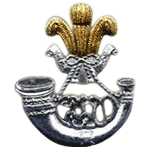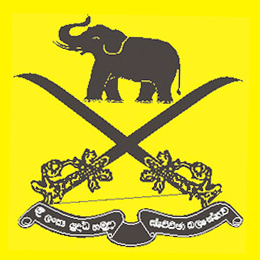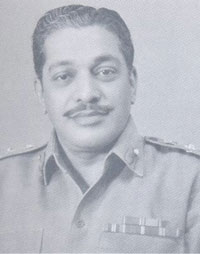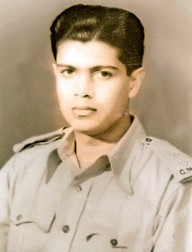The Ceylon Defence Force (CDF) was established in 1910 by the Ceylonese legislation Ceylon Defence Force Ordinance, which reformed the Ceylon Volunteer Force (CVF) that existed previously as the military reserve in the British Crown colony of Ceylon. At the time of forming it was only a reserve force but soon developed into a regular force responsible for the defence of Ceylon. The CDF was under the command of the General Officer Commanding, Ceylon of the British Army in Ceylon if mobilised. However mobilisation could be carried out only under orders from the Governor.

General Sir John Lionel Kotelawala was a Sri Lankan statesman, who served as the 3rd Prime Minister of Ceylon from 1953 to 1956.

The Sri Lanka Army is the oldest and largest of the Sri Lanka Armed Forces. Established as the Ceylon Army in 1949, it was renamed when Sri Lanka became a republic in 1972. In 2010, the Army had approximately 200,000 regular personnel, between 20,000 and 40,000 reserve (volunteer) personnel and 18,000 National Guardsmen and comprises 13 divisions, one air-mobile brigade, one commando brigade, one special forces brigade, one independent armored brigade, three mechanized infantry brigades and over 40 infantry brigades.

The Sri Lanka Armoured Corps (SLAC) provides the armour capability of the Sri Lanka Army, with vehicles such as the T-55AM2, and type 80/88 main battle tanks; the BMP infantry fighting vehicle; and the BTR-80, and WZ551 armoured personnel carriers. It comprises six regular armoured regiments, a volunteer regiment, and a regimental band. It has an independent Armoured Brigade and is headquartered at Rock House Army Camp, Colombo.

The Sri Lanka Artillery (SLA) is the artillery arm of the Sri Lanka Army. It is made up of ten regular regiments and two volunteer regiments. The SLA is headquartered at Panagoda Cantonment, Panagoda.
The Sri Lanka Engineers (SLE) is a combat support arm of the Sri Lanka Army which provides military engineering. It is made up of ten regular regiments and one volunteer regiment. Headquartered at Panagoda Cantonment, it is headed by the Centre Commandant.

The Sri Lanka Signals Corps (SLSC) is a combat support corps of the Sri Lanka Army, responsible for providing military communications, information technology and electronic warfare support. The corps is made up of a signals brigade, ten regular regiments and one volunteer regiment. It is responsible for installing, maintaining and operating all types of telecommunications equipment and information systems. It is headquartered at the Panagoda Cantonment.

The Sri Lanka Light Infantry (SLLI) is the oldest regiment in the Sri Lanka Army and the oldest infantry regiment in the army. It is made up of ten regular battalions and five volunteer battalions, and is headquartered at the Panagoda Cantonment, Panagoda. Over the years it has become the most distinguished and dependable regiment in the army.

The Sri Lanka Army Volunteer Force (SLAVF) is the active-duty volunteer reserve force of the Sri Lanka Army. The SLAVF is separate from the Regular Force which consists of personal who are professional soldiers and its Regular Reserve, which comprises personal who have a mobilization obligation following their service in the regular army. The SLAVF consists of the volunteer force and the volunteer reserve; administration and recruitment of reserve personal is carried out by the Volunteer Force Headquarters in Shalawa, Kosgama which is headed by the Commandant of the Volunteer Force. It has a current strength of about 55,000 personnel. The SLAVF was known as the Ceylon Volunteer Force from 1949 to 1972 and the Sri Lanka Volunteer Force from 1972 to 1985.
The Ceylon Planters Rifle Corps was a regiment of the Ceylon Defence Force, which existed between 1900 and 1949. It was a volunteer (reserve) regiment based in Kandy, made up of only Europeans that were tea and rubber planters of the hills of Sri Lanka. The regiment deployed personnel to fight in the Second Boer War, the First, and Second World Wars.

Between 1948 and 1972, Ceylon was an independent country in the Commonwealth of Nations, that shared a monarch with other dominions of the Commonwealth. In 1948, the British Colony of Ceylon was granted independence as Ceylon. In 1972, the country became a republic within the Commonwealth, and its name was changed to Sri Lanka.

General Deshamanya Don Sepala Attygalle, was a Sri Lankan army general, civil servant and diplomat. The longest serving Commander of the Sri Lankan Army (1967–1977), he went on to serve as the Permanent secretary to the Ministry of Defence and Sri Lankan High Commissioner to the United Kingdom.

The Sri Lanka Army Pioneer Corps (SLAPC) is a (reserve) regiment of the Sri Lanka Army. Established as manpower reserve to be utilized in times of strikes and union action to maintain the functionality of essential services and other state functions, other such units that existed then and has since been disband include the Post and Telegraph Signals (PTS) and the Ceylon Railway Engineer Corps (CREC). With the escalation of the Sri Lankan Civil War the regiment has taken up combat duties.

General Tissa Indraka Weeratunga, VSV was a Sri Lankan senior general. He was a former Commander of the Sri Lankan Army and first general officer commanding (GOC) of the Joint Operations Headquarters (JOH), he was later Sri Lanka's High Commissioner to Canada.

The Army Headquarters is the headquarters of the Sri Lanka Army and is located in the Defence Headquarters Complex in Sri Jayawardenapura Kotte. It was established on 1 October 1949 in the Echelon Barracks which was the headquarters of the British Army in Ceylon. It later moved to the Rifle Barracks and then to the Old Army Headquarters Complex, before moving to the new Defence Headquarters Complex.

The Sri Lanka Armed Forces is the overall unified military of the Democratic Socialist Republic of Sri Lanka encompassing the Sri Lanka Army, the Sri Lanka Navy, and the Sri Lanka Air Force; they are governed by the Ministry of Defence (MoD). The three services have around 346,700 active personnel; conscription has never been imposed in Sri Lanka.
Major General Deshamanya Alexander Richard Udugama, MBE was a Sri Lankan military leader, politician and diplomat. Former Army Commander (1964–1966), he was elected as Member of Parliament for Matale from 1970 to 1977 and served as Sri Lankan Ambassador to Iraq from 1979 to 1982. He was accused of an alleged coup d'état in 1966.

Lieutenant Colonel Dr. Anthony St. Clare Rex de Costa, MBE, CAVF was a renowned Sri Lankan medical doctor and soldier. He was the commanding officer of the Ruhunu Regiment, a doctor in the Ceylon Defence Force during World War II and a vice president of the World Veterans Federation. He was assassinated by the JVP during the 1971 Insurrection.
The Government of Sri Lanka maintains intelligence agencies that conduct intelligence activities to support the national security of Sri Lanka. Their intelligence assessments contribute to the conduct of national security, military planning and law enforcement. The main organisations are the State Intelligence Service and the Directorate of Military Intelligence. These intelligence agencies are coordinated by the Chief of National Intelligence (CNI), who reports to the Secretary of Defense.
The Ceylon National Guard (CNG) was a former Volunteer regiment of the Sri Lanka Army that existed from 1963 to 1980. The CNG was formed in 1962 as part of the reforms to the Ceylon Volunteer Force in the Ceylon Army following the 1962 Ceylonese coup d'état attempt in which several volunteer units were implicated. The 2nd (Volunteer) Coastal Artillery Regiment, Ceylon Artillery and the 2nd (Volunteer) Signals, Ceylon Signals Corps were disbanded and personal from these units who were found to be not part of the attempt coup were re-grouped as the 1st Battalion, CNG and 2nd Battalion, CNG. The CNG was mobilized for duty with the Task Force Anti Illicit Immigration and during the 1971 JVP Insurrection. It was finally disbanded in 1980 after the 1st Battalion was transferred to the Sri Lanka Armoured Corps as the 2nd (Volunteer) Regiment, Sri Lanka Armoured Corps in 1979 and the 2nd Battalion was transferred to the Sri Lanka Artillery as the 5th (Volunteer) Regiment, Sri Lanka Artillery in 1980.














